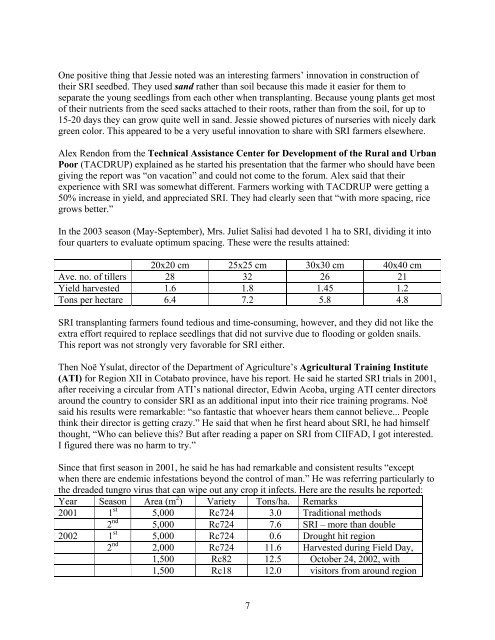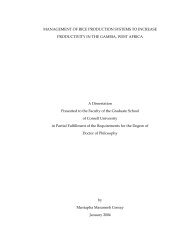report on a visit to the philippines to review sri progress
report on a visit to the philippines to review sri progress
report on a visit to the philippines to review sri progress
Create successful ePaper yourself
Turn your PDF publications into a flip-book with our unique Google optimized e-Paper software.
One positive thing that Jessie noted was an interesting farmers’ innovati<strong>on</strong> in c<strong>on</strong>structi<strong>on</strong> of<br />
<strong>the</strong>ir SRI seedbed. They used sand ra<strong>the</strong>r than soil because this made it easier for <strong>the</strong>m <strong>to</strong><br />
separate <strong>the</strong> young seedlings from each o<strong>the</strong>r when transplanting. Because young plants get most<br />
of <strong>the</strong>ir nutrients from <strong>the</strong> seed sacks attached <strong>to</strong> <strong>the</strong>ir roots, ra<strong>the</strong>r than from <strong>the</strong> soil, for up <strong>to</strong><br />
15-20 days <strong>the</strong>y can grow quite well in sand. Jessie showed pictures of nurseries with nicely dark<br />
green color. This appeared <strong>to</strong> be a very useful innovati<strong>on</strong> <strong>to</strong> share with SRI farmers elsewhere.<br />
Alex Rend<strong>on</strong> from <strong>the</strong> Technical Assistance Center for Development of <strong>the</strong> Rural and Urban<br />
Poor (TACDRUP) explained as he started his presentati<strong>on</strong> that <strong>the</strong> farmer who should have been<br />
giving <strong>the</strong> <str<strong>on</strong>g>report</str<strong>on</strong>g> was “<strong>on</strong> vacati<strong>on</strong>” and could not come <strong>to</strong> <strong>the</strong> forum. Alex said that <strong>the</strong>ir<br />
experience with SRI was somewhat different. Farmers working with TACDRUP were getting a<br />
50% increase in yield, and appreciated SRI. They had clearly seen that “with more spacing, rice<br />
grows better.”<br />
In <strong>the</strong> 2003 seas<strong>on</strong> (May-September), Mrs. Juliet Salisi had devoted 1 ha <strong>to</strong> SRI, dividing it in<strong>to</strong><br />
four quarters <strong>to</strong> evaluate optimum spacing. These were <strong>the</strong> results attained:<br />
20x20 cm 25x25 cm 30x30 cm 40x40 cm<br />
Ave. no. of tillers 28 32 26 21<br />
Yield harvested 1.6 1.8 1.45 1.2<br />
T<strong>on</strong>s per hectare 6.4 7.2 5.8 4.8<br />
SRI transplanting farmers found tedious and time-c<strong>on</strong>suming, however, and <strong>the</strong>y did not like <strong>the</strong><br />
extra effort required <strong>to</strong> replace seedlings that did not survive due <strong>to</strong> flooding or golden snails.<br />
This <str<strong>on</strong>g>report</str<strong>on</strong>g> was not str<strong>on</strong>gly very favorable for SRI ei<strong>the</strong>r.<br />
Then Noë Ysulat, direc<strong>to</strong>r of <strong>the</strong> Department of Agriculture’s Agricultural Training Institute<br />
(ATI) for Regi<strong>on</strong> XII in Cotaba<strong>to</strong> province, have his <str<strong>on</strong>g>report</str<strong>on</strong>g>. He said he started SRI trials in 2001,<br />
after receiving a circular from ATI’s nati<strong>on</strong>al direc<strong>to</strong>r, Edwin Acoba, urging ATI center direc<strong>to</strong>rs<br />
around <strong>the</strong> country <strong>to</strong> c<strong>on</strong>sider SRI as an additi<strong>on</strong>al input in<strong>to</strong> <strong>the</strong>ir rice training programs. Noë<br />
said his results were remarkable: “so fantastic that whoever hears <strong>the</strong>m cannot believe... People<br />
think <strong>the</strong>ir direc<strong>to</strong>r is getting crazy.” He said that when he first heard about SRI, he had himself<br />
thought, “Who can believe this? But after reading a paper <strong>on</strong> SRI from CIIFAD, I got interested.<br />
I figured <strong>the</strong>re was no harm <strong>to</strong> try.”<br />
Since that first seas<strong>on</strong> in 2001, he said he has had remarkable and c<strong>on</strong>sistent results “except<br />
when <strong>the</strong>re are endemic infestati<strong>on</strong>s bey<strong>on</strong>d <strong>the</strong> c<strong>on</strong>trol of man.” He was referring particularly <strong>to</strong><br />
<strong>the</strong> dreaded tungro virus that can wipe out any crop it infects. Here are <strong>the</strong> results he <str<strong>on</strong>g>report</str<strong>on</strong>g>ed:<br />
Year Seas<strong>on</strong> Area (m 2 ) Variety T<strong>on</strong>s/ha. Remarks<br />
2001 1 st 5,000 Rc724 3.0 Traditi<strong>on</strong>al methods<br />
2 nd 5,000 Rc724 7.6 SRI – more than double<br />
2002 1 st 5,000 Rc724 0.6 Drought hit regi<strong>on</strong><br />
2 nd 2,000 Rc724 11.6 Harvested during Field Day,<br />
1,500 Rc82 12.5 Oc<strong>to</strong>ber 24, 2002, with<br />
1,500 Rc18 12.0 <strong>visit</strong>ors from around regi<strong>on</strong><br />
7

















